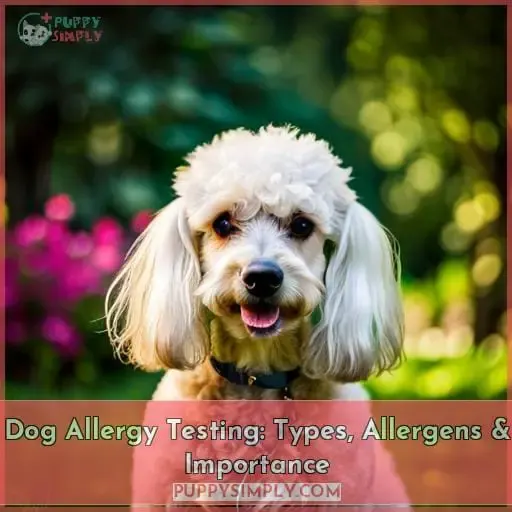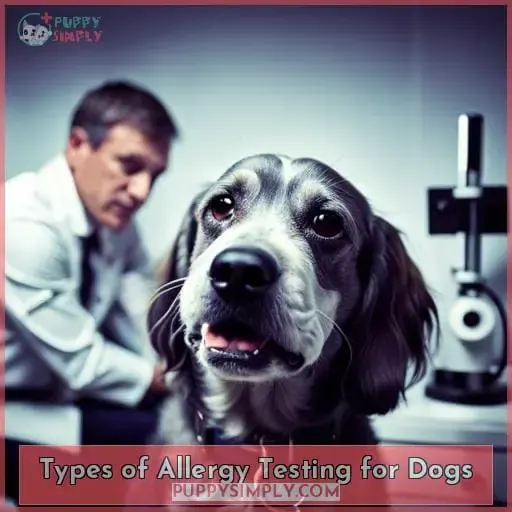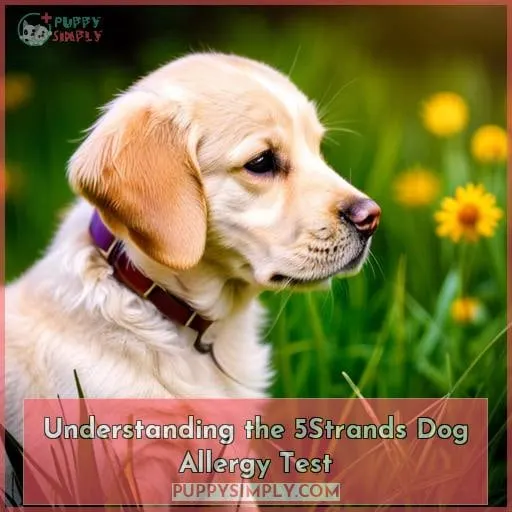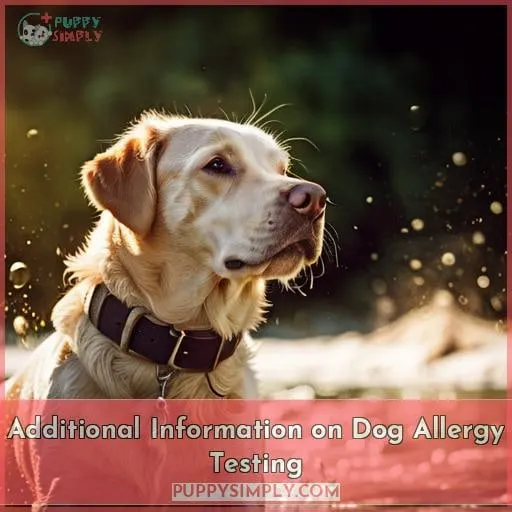This site is supported by our readers. We may earn a commission, at no cost to you, if you purchase through links.
 Ah, the joys of pet ownership. But what happens when our furry friends start to experience strange symptoms? If your pooch is showing signs of itchy skin or gastrointestinal issues, they may be suffering from allergies—and dog allergy testing can help you determine the cause.
Ah, the joys of pet ownership. But what happens when our furry friends start to experience strange symptoms? If your pooch is showing signs of itchy skin or gastrointestinal issues, they may be suffering from allergies—and dog allergy testing can help you determine the cause.
From IgE and immediate tests to at-home methods and RAST testing, there are a variety of ways veterinarians diagnose canine allergies. With an understanding of common allergens like environmental triggers and food sensitivities as well as the importance in addressing atopy through such tests, we’ll explore how best to approach dog allergy testing for your pup’s optimum health.
Table Of Contents
- Key Takeaways
- Types of Allergy Testing for Dogs
- Common Allergens in Dogs
- Importance of Allergy Testing for Dogs With Atopy
- How Allergy Testing is Performed in Dogs
- Considerations for RAST Testing in Dogs
- Understanding the 5Strands Dog Allergy Test
- Evaluating the Effectiveness of the 5Strands Test
- Additional Information on Dog Allergy Testing
- Conclusion
Key Takeaways
- There are multiple methods for testing dog allergies, including IgE testing, at-home allergy kits, intradermal testing, serum testing, and RAST testing.
- Common dog allergens include food ingredients and environmental triggers such as fleas, dust mites, pet dander, and pollen.
- Allergy testing is important for dogs with environmental allergies, known as atopy, and can help identify signs such as itchy skin, ear infections, and gastrointestinal issues.
- Allergy testing can pinpoint specific allergens for avoidance or immunotherapy, allowing for better management of dog allergies.
Types of Allergy Testing for Dogs
If your dog is experiencing allergies, there are several tests that can help you determine the cause. IgE allergies are immediate and may be diagnosed with blood or skin tests. At-home allergy test kits focus on food and environmental factors, such as fleas, dust mites, molds, or pollens.
Intradermal testing injects allergens under the skin to identify reactions, while serum testing examines blood for sensitivity to various allergens. RAST (radioallergosorbent) testing helps diagnose allergies in dogs by identifying various environmental allergens, which makes it valuable when considering hyposensitization therapy as a solution for treating pet allergies.
IgE Allergies and Immediate Testing
You may need to undergo a blood or skin test if your pup is showing signs of an IgE allergy, which can manifest quickly with symptoms such as vomiting and hives. Immediate testing options include intradermal and serum tests, while RAST testing helps diagnose environmental allergies.
Before choosing one method over another, consider costs and other factors like sedation requirements for the patient.
At-Home Allergy Tests and Their Focus
Experience the power of at-home allergy tests to quickly uncover food and environmental sensitivities in your pet! Benefits include comparing different test kits, choosing reliable companies, interpreting results for successful pet allergy management.
Saliva and hair samples can reveal common allergies like dairy, beef, or wheat, plus environmental factors such as fleas, molds, and pollens. With these insights, you’re empowered to make informed decisions about your pup’s health.
Intradermal and Serum Allergy Testing
Discover how intradermal and serum allergy testing can help diagnose your pup’s sensitivities. Intradermal injection identifies reactions to allergens, while blood tests detect sensitivity levels. Costs vary; consult a veterinary dermatology specialist for accuracy. Alternatives such as at-home kits focus on food and environmental factors but may not identify atopy signs or rule out other conditions.
RAST Testing and Its Benefits
RAST testing, also known as radioallergosorbent test, is an effective way to diagnose allergies in pets. It’s more accessible than intradermal tests and can be done without sedation. RAST tests measure the level of antibodies present, which helps determine a pet’s sensitivity to various allergens.
Results are compared against standards for accuracy and interpreted by a veterinarian or dermatologist recommending hyposensitization therapy if needed.
Common Allergens in Dogs
When it comes to dog allergies, the most common sources are food allergens and environmental triggers. This means that your pup may be sensitive or allergic to dairy, beef, wheat, or other foods as well as dust mites, fleas, and pollens in their environment.
Food Allergens
Uncover the hidden dangers of food allergens in your pup’s diet and protect them from uncomfortable reactions! Food allergen testing helps identify intolerances to specific ingredients like chicken, beef, grains, or dairy.
Allergy tests measure sensitivity levels with varying accuracy; consult a vet if symptoms persist after dietary changes.
Restricting pet food choices can help manage allergies but requires careful monitoring. Even hypoallergenic foods may contain trace elements of allergens that trigger flare-ups. Dietary restrictions should be viewed as part of an overall allergy management plan and not just for symptom relief alone.
Investigate options such as 5Strands intolerance test or seek professional advice about hyposensitization therapy to keep your pup feeling their best!
Environmental Triggers
Uncovering the source of your pup’s allergies can be a challenge, but environmental triggers are often to blame. Allergy tests help identify hidden causes such as fleas, dust mites, pet dander, and pollen.
Managing these allergies requires understanding their symptoms and taking preventative measures.
To accurately test for environmental factors, opt for hair sample or bioresonance technology-based allergy kits. These kits will provide detailed results about what allergens affect your dog the most. With this knowledge, you’ll be able to make informed decisions about medications and lifestyle changes that can improve your pup’s quality of life.
Reducing exposure to allergens in the home environment can be achieved through various methods. Using air purifiers and regularly washing your dog’s bedding can help minimize allergens. It’s also important to avoid contact between pets if they have allergies. During bathing, using hypoallergenic shampoo can be beneficial as well.
By addressing environmental triggers and implementing these measures, you can help alleviate your pup’s allergies and enhance their overall well-being.
Importance of Allergy Testing for Dogs With Atopy
Suffering from chronic itchy skin, recurrent ear infections, or constant licking and chewing? Your dog may have atopic dermatitis, or environmental allergies. Targeted allergy testing can identify specific triggers to allow for allergen avoidance or immunotherapy to relieve your dog’s misery.
The importance of allergy testing for dogs with atopy cannot be overstated. Itching, licking, and ear infections often indicate allergic sensitivities. Pinpointing the precise allergens through testing empowers owners to minimize exposure through avoidance or pursue immunotherapy.
Effectively treating the underlying cause enhances dogs’ quality of life and comfort. Discuss testing options with your veterinarian if your pet struggles with chronic skin or ear conditions for prolonged relief from their suffering.
A simple test can unveil solutions and markedly improve their health and happiness.
Signs of Atopy in Dogs
Identifying the signs of atopy in your pup can be a complex process. Allergy symptoms like itchy skin, ear infections, and gastrointestinal issues may indicate atopy. Consult your veterinarian about allergy testing to pinpoint triggers. Methods such as intradermal skin testing, serum IgE testing, and RAST can help diagnose allergens.
Controlling exposure and hyposensitization therapy may then provide relief. Though tempting, avoid relying solely on at-home tests.
Role of Allergy Testing in Addressing Atopy
You’ll want to get Rover tested to pinpoint his triggers before starting allergy shots. Testing helps identify specific allergens causing symptoms. This allows customized allergy vaccine therapy.
- Confirming diagnosis
- Guiding management
- Monitoring progress
- Assessing treatment
- Preventing recurring issues
How Allergy Testing is Performed in Dogs
Allergy testing in dogs is critical for identifying the underlying causes of symptoms. Intradermal testing involves injecting potential allergens under the skin and observing for localized reactions, while serum testing examines blood samples for IgE antibodies against specific allergens.
Intradermal Testing Procedure
Discovering your pup’s allergy root cause requires a thorough, precise test like intradermal testing. Intradermal tests accurately identify environmental allergens, making it easier to create an effective hyposensitization program for long-term relief.
Benefits include more accurate allergy shot process, higher food intolerance detection rate, and improved hyposensitization therapy effectiveness. The procedure involves injecting small allergen extract amounts into shaved or clipped skin areas.
This is followed by observing signs like red, itchy skin or chronic ear infections when exposed to specific allergens.
Serum Testing Procedure
Let’s examine how serum testing identifies allergens through blood analysis. It has a number of benefits: it can more accurately identify allergies, is cost-effective in comparison to other types of tests, and provides numerous options for allergy identification.
The test interpretation process is also very straightforward; results are available quickly and can be easily understood by pet owners. Serum testing also helps guide hyposensitization therapy, which involves exposing dogs to allergens to build immunity tolerance over time.
While this type of test may not diagnose atopic dermatitis itself, it does help narrow down potential causes that trigger allergic reactions in order for the proper treatment plan to be created accordingly.
- More accurate than other types of tests
- Cost-effective compared with others
- Numerous options for identifying allergies
- Quickly produces understandable results
- Helps guide hyposensitization therapy
Considerations for RAST Testing in Dogs
When considering RAST testing for your dog’s allergies, it is important to consider the impact of their current medications on the results. Additionally, it can be beneficial to compare and contrast this test with intradermal testing as there are some drawbacks that should be considered before proceeding.
Medication Usage Prior to RAST Testing
You’d better keep your dog on allergy meds while undergoing RAST testing. It’s important to note that medication usage prior to the test can influence results and diagnosis.
Your vet will need to know what type of treatment preparation was done in order for them to accurately diagnose allergies and determine the best course of action moving forward.
Drawbacks of RAST Testing Compared to Intradermal Testing
Comparing RAST testing and intradermal testing, there are a few drawbacks to consider. While RAST tests can detect environmental allergens that may cause problems for dogs, their accuracy is lower than intradermal’s.
Additionally, the cost of an in-office serum test is much higher than at-home options like 5Strands Pet Standard Test.
Despite being more accessible and requiring less sedation or interruption to medications during administration, many vets still prefer using the more expensive option due to its increased accuracy. Intradermal tests also provide results faster compared with those from RAST tests which can take up to two weeks or longer depending on the lab used.
When it comes down to choosing between these two types of allergy tests for your dog, it’s important to weigh both pros and cons before making a decision about what works best for them.
Understanding the 5Strands Dog Allergy Test
The 5Strands Dog Allergy Test promises to identify and measure a dog’s intolerance levels towards 275 different food ingredients and 105 environmental factors. This test is based on bioresonance technology, which uses hair samples to determine the tolerance levels of an individual pet.
Understanding how this test works can help provide insight into your dog’s allergies or intolerances.
Test Promises and Coverage
According to the coverage of the 5Strands Pet Standard test, it checks your dog’s compatibility with 275 food ingredients and 105 environmental factors for $148. It uses hair samples and bioresonance technology that promises accurate results without sedation or expensive intradermal testing.
Results arrive within 7 days via email, categorizing intolerances into Level 1, 2, or 3.
Test limitations include a lack of scientific evidence on why it works, cost considerations, as well as the need for patience in interpreting test results over 6-8 weeks of systematic testing. Therefore, consult Newtown vets for immediate care during a pet emergency before relying solely on this at-home option to diagnose allergies like runny eyes and itchy ears.
Working Mechanism of the 5Strands Test
Since the bioresonance technology detects electromagnetic frequencies, the 5Strands test identifies intolerances without needing actual allergen material. Through the analysis of a hair sample, the test detects compatible and incompatible frequencies.
Results listing your dog’s intolerance levels to various ingredients arrive within a week via email. While some owners report success, more evidence on the technology’s scientific validity would be beneficial.
Consult your veterinarian, like Dr. Rebecca Greenstein, on integrating these results into an elimination diet trial using sensitive formulas from Purina Pro Plan.
Evaluating the Effectiveness of the 5Strands Test
As pet owners seek to understand their canine companion’s health, the effectiveness of the 5Strands dog allergy test has been evaluated in various ways. Testimonials and personal experience have both been used as evidence for its potential benefits in identifying intolerances and aiding desensitization therapy.
Testimonials and Personal Experience
Have you heard of others who have had success with the 5Strands test? Pet owners report improved allergy management, more accurate testing results, and less need for medications.
- Improved symptoms in pets within days of changing diets
- Reduced sensitivity to environmental allergens after RAST testing
- Obvious improvement in skin condition and coat health
- Greater understanding about pet food ingredients
- Enhanced comfort level for both pets and owners. Allergy relief can be challenging, but pet parents find that the 5Strands test helps them manage their furry friend’s sensitivities better.
Scientific Evidence and Criticisms
You may have heard about the 5Strands test – but how effective is it really? The scientific validity of this at-home dog allergy test has yet to be established. While some consumers report successful outcomes, others criticize its lack of accuracy and reliability.
Alternative methods, such as intradermal or serum testing, are more reliable for identifying allergies in dogs. For hyposensitization therapy, RAST testing is recommended due to its ability to identify environmental allergens accurately.
The effectiveness and accuracy of 5Strands should be weighed against customer experiences before deciding if this type of testing suits your pet’s needs best.
Additional Information on Dog Allergy Testing
When it comes to dog allergy testing, consulting with a veterinarian is essential. In the event of an emergency, contact your local vet for immediate care. Additionally, explore options such as supplements and hypoallergenic foods that may help manage allergies in dogs.
Consultation With a Veterinarian
It’s important to consult your veterinarian before relying solely on at-home test results for allergies.
- Identifying allergy symptoms like itching, paw chewing, or gut issues.
- Determining which type of testing best suits your pup.
- Assessing common allergens such as food and environmental factors.
- Discussing the costs and considerations associated with tests available.
- Exploring hyposensitization therapy options based on RAST test results from 5Strands or other sources if needed. A thorough assessment is key in understanding how to manage canine allergies effectively for long-lasting relief!
Pet Emergency Care
In the event of a pet emergency, contact Newtown Vets for immediate care. They provide veterinary assistance and have established protocols to respond quickly in urgent pet situations. Their team is well-equipped to administer appropriate procedures and treatments on-site or at an animal hospital if needed.
With their expertise, you can be sure that your beloved companion will get immediate attention and receive quality medical care when needed most.
Allergy Supplements and Hypoallergenic Foods
To manage allergies, consider trying supplements and hypoallergenic foods to see if they can help reduce symptoms. Allergy-friendly treats, like Omega-3 fatty acids and probiotics, may aid in alleviating inflammation related to allergic reactions.
Amino acid chelates or vitamins A, C & E have also been shown to be beneficial.
Alternatively, a hypoallergenic diet eliminates common allergy triggers such as dairy products and grains for at least six weeks to identify allergens causing the reaction.
Lastly, allergen avoidance strategies include vacuuming often with an HEPA filter vacuum cleaner, using air filters inside your home, reducing contact with grasses during peak seasons when possible, and keeping windows closed in pollen season.
More importantly, seek advice from your vet before starting any new treatments!
Conclusion
Pets are an important part of our lives, and when they’re suffering from allergies, it can be heartbreaking. Dog allergy testing is a crucial step in identifying the allergens that are causing the discomfort, and the results can be used to create a treatment plan.
IgE allergies require immediate testing, while at-home tests can help identify food and environmental triggers. Intradermal and serum testing are performed by a vet, and RAST testing can identify environmental allergens.
Common allergens include food ingredients and environmental triggers such as fleas, molds, and pollens.
Allergy testing is especially important for dogs with atopy, as it can help identify the cause of the allergy and guide hyposensitization therapy. With the right dog allergy testing, you can get your pet the relief they need and give them the happy and healthy life they deserve.














